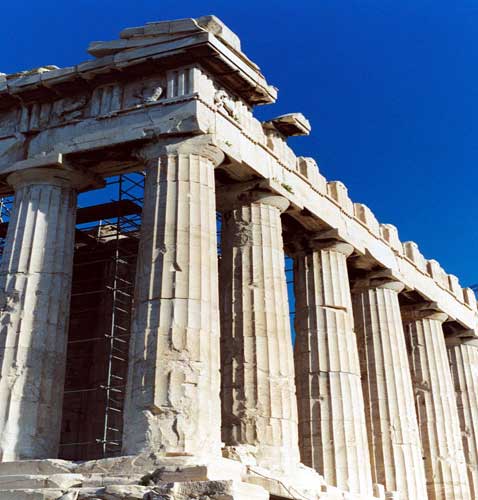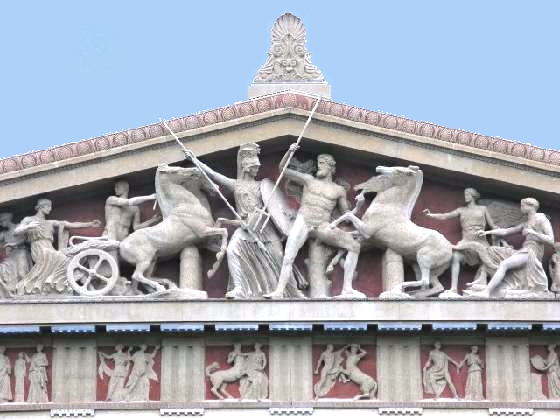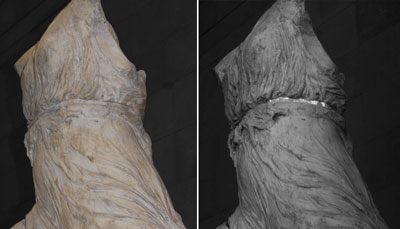
Today, the Parthenon temple that watches over Athens is a pure, white building, dazzlingly bright on sunny days against the deep blue sky. But it wouldn't have looked anything like this in ancient Greek times. Researchers at the British Museum announce today that they have detected tiny traces of blue paint on the building's sculptures - suggesting that the temple's statues and friezes would have been not stark white, but a riot of colour.
I've just written a short story on the work for New Scientist, which you can read here. Although only a few hints of a pigment called Egyptian blue have been detected so far, experts think that the original paint job would have included red as well, with the original marble showing through white in places, and highlights of gold in others (see second pic below for one interpretation of what this might have looked like). Although we have the benefit of seeing the sculptures on display at eye level, for the ancient Greeks they were fixed around the top of the temple - 40 feet high. "Colouring would have hugely enhanced the visibility," says senior curator Ian Jenkins, who is responsible for the Parthenon sculptures held at the British museum.
Scholars have long known that the Greeks painted their marble buildings and statues, but they're particularly excited about this work because despite two hundred years of searching it hasn't been seen before on the Parthenon's sculptures (there used to be some visible traces on the mouldings just  underneath the roof, but not on the sculptures themselves). In the end, post-doc Giovanni Verri used a clever imaging technique called photo-induced luminescence to pick up microscopic specks of pigment. When red light is shone onto the molecules of Egyptian blue, they absorb it and emit infrared light. Seen through a camera sensitive to infrared, any parts of the marble that were once blue appear to glow.
underneath the roof, but not on the sculptures themselves). In the end, post-doc Giovanni Verri used a clever imaging technique called photo-induced luminescence to pick up microscopic specks of pigment. When red light is shone onto the molecules of Egyptian blue, they absorb it and emit infrared light. Seen through a camera sensitive to infrared, any parts of the marble that were once blue appear to glow.
So far Verri has found the blue in a few different places - for example on the belt of the messenger goddess Iris from the temple's west pediment (see the pic below from the British Museum - there's a normal photo on the left, and an infra-red image showing Iris's glowing belt on the right). Depicted as she descends to earth, she's famous for her life-like flapping tunic. Verri also detected blue stripes on a cloak draped over the knees of the goddess Dione, from the east pediment. It's amazing to think that when in full colour, the Parthenon's sculptures showed details down to the weave pattern of a figure's clothing.
 One thing that interests me, though, is why the public perception of Greek temples and sculptures is of simple white buildings, when there's so much evidence that they were actually brightly coloured. I asked Jenkins about this and he described it as "a conspiracy of collective amnesia".
One thing that interests me, though, is why the public perception of Greek temples and sculptures is of simple white buildings, when there's so much evidence that they were actually brightly coloured. I asked Jenkins about this and he described it as "a conspiracy of collective amnesia".
"We don't want to know it," he says. "We want to believe that ancient sculpture was white and pure." He believes that instead of paying attention to how the Greeks really lived, we're judging them according to our own aesthetic standards - for example the idea that it would be abhorrent to cover up beautifully-carved quality marble with coloured paint. He thinks the delusion stems from the Renaissance - when artists producing sculptures inspired by those of ancient Greece left them white to dissociate them from the previous Gothic style.
Jenkins also told me of his intriguing theory that the Parthenon's colour was affected by a severe climate disruption which caused a "year without summer" in the sixth century AD. I'll write about that in the next post...